Convalescent
The second convalescent home to be built in Swanley was the Hospital Convalescent Home (the first was the Kettlewell, for patients from St Bartholomew's Hospital).
On 1st January 1890 The Times published an anonymous letter addressed to Sir William Savory, the senior surgeon at St Bartholomew's Hospital, appointing him and Mr W.H. Cross, the Clerk to the Governors of that Hospital, to act with the writer as joint trustees for the administration of £100,000 which he had set aside for the purpose of establishing a convalescent home for other London hospitals.
The writer of the letter and the donor of the large sum of money was later revealed to be Mr Peter Reid, a member of the Stock Exchange. A friend of his also gave £50,000 on the understanding that his name would never be revealed.
The trustees purchased Parkwood, an estate of about 50 acres of land at Swanley, some 18 miles from London, for £8,000. They also contributed to the building expenses which, with the furnishings, came to £44,000.
The
Hospital Convalescent Home opened on 9th June
1893 and, although it was endowed by Peter Reid to the Westminster Hospital, other London
hospitals were permitted to send their patients there in the very early
stages of
their convalescence (most convalescent homes only took people in the
later stages). As with other voluntary hospitals no cases
of advanced tuberculosis, infectious or contagious disease, insanity or
epilepsy were accepted. Thirty beds were allocated to the London
Hospital, 20 each to St Thomas'
Hospital, Guy's
Hospital and the Middlesex Hospital,
and 15 each to
the Westminster Hospital and St
Mary's Hospital.
The main buildings consisted of three parts - a administration block in the centre, flanked by a female wing with 40 beds on the right and a male wing with 80 beds on the left, all laid with oaken parquet floors.
The male wing contained two smoking rooms and four day rooms with pleasant verandahs. The dormitories were on the floor above.
Each ward was named after a saint. Each bed had its own bedside locker and, under each bed, was a deep tray in which day clothes were placed at night.
The head gardener had his own cottage and other gardeners came in daily to look after the vegetable and flower beds. Every week the wards were filled with flowers from the estate.The Gothic chapel, located behind the main building, had been paid for and partly endowed by Mr Ebenezer Homan.
The medical staff consisted of a resident doctor, with a specialist visiting from London every day.
Patients stayed on average 3 to 5 weeks. Two-thirds were recovering from surgery, many railway workers who had suffered from accidents on the railway, or those involved in road traffic accidents. Their convalescence was free, the parent hospital even paying their rail fares.
Patients were met at the station and conveyed to the Home. They were not allowed to leave the grounds, not even to go to the village, a mile away. However, the estate was large and, during the summer, sports such as cricket, quoits and athletic events took place, including sack races and the Victoria Cross race (those who ran each had to carry a cripple). Cripples on crutches could also race for a 9d (4p) prize, although those with bad hearts or bad wounds were excluded. Indoor games were provided for rainy days.
The three Trustees - Mr Peter Reid (the founder), Sir William Savory and Mr W.H. Cross - met fortnightly to deal with any issues arising in the running of the Home.
In 1895 Peter Reid donated a further £50,000. which provided an income for the Home of £5,000. After two years of operation, some 2,200 patients had been admitted to the Home.
At the outbreak of WW1 the Home closed. In 1917, when the ammunition factory in Silvertown blew up, some 287 homeless children and their teachers were accommodated at the Home free of charge for five months. After this, the Home was used as a military hospital, receiving convalescent soldiers with facial injuries from the Queen's Hospital in Sidcup.
After the war the Home re-opened for convalescent patients from the London hospitals.
During WW2 it became the Parkwood Auxiliary Hospital and Convalescent Home, run by the Red Cross for convalescent servicemen, especially from the army.
In 1948 the Home became part of the NHS along with its parent hospital. It was renamed the Westminster Hospital (Parkwood) Convalescent Home, with beds for 80 women and 40 children (boys aged from 3 to 9 years). (The Westminster Hospital also had two other convalescent home - the Yarrow Convalescent Home for children in Broadstairs and Chartham Park Convalescent Home for men near East Grinstead.) Parents were allowed to visit their children once a month, but adult patients could have a weekly visit every Sunday.
Once patients from the Westminster Hospital Group had been accommodated, any surplus beds were placed at the disposal of other hospitals in the South West and South East Metropolitan regions. The weekly cost per patient to the parent hospital was 10 guineas (£10.50).
In 1952 The Home had 120 beds, including 6 for mothers with young children. Only 80 beds were open (St George's Ward with 40 beds was closed) because of the lack of nursing staff. The nursing complement consisted of a Matron, 6 State Registered Nurses and 15-20 student nurses. There was a Resident Medical Officer, while consultants from Westminster attended when necessary.
The beds were in wards of 12 or 5 beds each. Most patients stayed on average for three weeks. Breakfast was served at 8.30 a.m. and patients went to bed at 8.30 p.m. after a light supper.
In 1958 the Home had 110 beds.
It continued to function until the early 1960s, when it closed.
Present status (December 2008)
Parkwood still exists in its entirety. In 1971 it became the the Kensington & Chelsea Parkwood Hall School, hidden in private grounds.
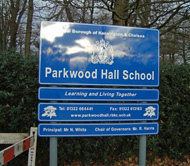
Signage for Parkwood Hall School.
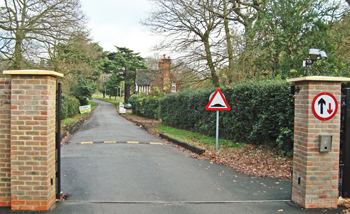
The entry driveway to the School.
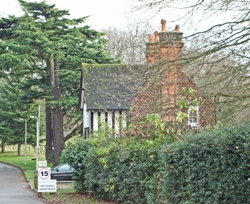
The Lodge just inside the driveway.
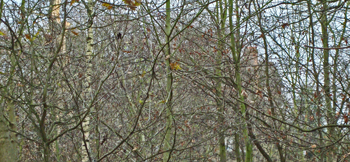
The main building is mainly obscured by surrounding trees.
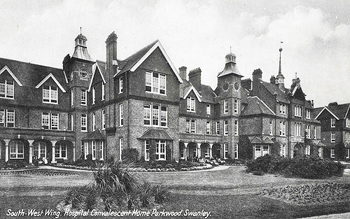
The southwest wing of the Hospital Convalescent Home.
(Photograph reproduced by kind permission of
robmcrorie - flickr)
(Author unstated) 1893 Reflections from a Board Room mirror. Nursing Record Hospital World Supplement, 13th July, 3-4.
(Author unstated) 1895 Refitting for the struggle. A visit to the 'Hospital Convalescent Home' at Parkwood, Swanley, Kent. The Quiver. Filed as H02/PCH/Y/02/001 at the
London Metropolitan Archives.
(Author unstated) 1917 List of the various hospitals treating military cases in the United Kingdom. London, H.M.S.O.
(Author unstated) 1921 The Hospital World. British Journal of Nursing, 19th November, 320.
http://archiver.rootsweb.ancestry.com
www.aim25.ac.uk
www.bbc.co.uk
www.oldukphotos.com (1)
www.oldukphotos.com (2)
www.swanleytowncouncil.gov.uk
Return to home page